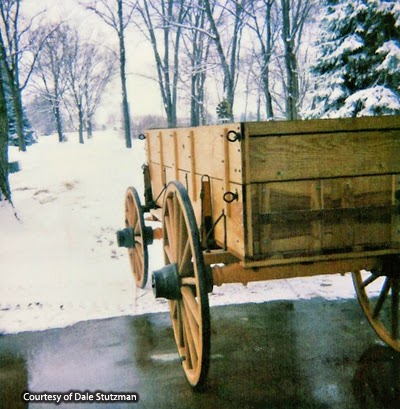Living in an age where visual arts have
enjoyed so much progress can make it tempting to take the work of graphic
design for granted. Modern advances in
digital photography, clip art, computerized image manipulation, and stock photo
availabilities make it significantly easier to produce eye-catching advertising
in the 21st century.
Looking back to the late 1800’s,
promotional expressions were not so simple.
Businesses desiring a tailored polish to their marketing materials were
at the mercy of the tedious, costly, and highly skilled craft of engraving as
well as the burgeoning lithographic processes.
As such, quick turnarounds on elaborate, custom printings weren’t commonplace
during the 1870’s and ‘80’s.
Nevertheless, many agricultural
companies of the day took great pains to set themselves apart in
advertising. Prominent wagon makers were
no exception. From dynamic depictions of
frontier scenes to the use of vibrant colors and exquisite line work, countless
designs were meticulously fashioned and widely distributed by savvy western
vehicle marketers like Peter Schuttler, Mitchell, Bain, Moline, Jackson, and
Studebaker. Among the early pieces in
the Wheels That Won The West® archives are several produced by a wagon company
launched on the edge of the American frontier just after the Civil War. Today, the manufacturer is best known as the
Star Wagon Company from Cedar Rapids, Iowa.
 |
As shown in this early 1880’s letterhead and receipt, the Star Wagon Company produced impressive graphics to accompany their acclaimed vehicles. |
According to the 1878 book, “The History
of Linn County Iowa,” the organization began its life in 1866 as Upton,
Chambers, and Company. Even so, it seems
the firm’s brand may have always been aligned with the five-pointed celestial
name. A very early local advertisement
from 1867 refers to the vehicles as ‘Star Wagons.’
In 1871, the business was officially
incorporated and the name was changed from Upton, Chambers, and Company to the
“Star Wagon Company.” Almost before the
ink on the incorporation papers was dry, the firm suffered a devastating
fire. In the aftermath, the charred
wooden remains were replaced with brick structures. The rebuilding process was completed in 1872. By 1877, the company was producing 3,000
vehicles per year and, within another couple years, the enterprise had become
recognized as one of the leading wagon builders for the western trade. (See our December 10, 2014 blog for more details).
One of the greater complications for a
number of larger-scale wagon makers during the late 1800’s was the use of
prison labor by a few private sector vehicle builders. On the surface, it sounds like a pretty good
idea; put felons to work, teach ‘em a trade, and keep ‘em out of more trouble –
all the while helping reduce costs in the penal system. Like any good idea, though, there’s likely
somebody somewhere waiting to exploit it.
The problem? Convicts were paid a
mere fraction of the day rates required by those hiring from the general
populace. It was a situation that
allowed some large-scale builders to drastically undercut prices to the public
as well as in government bids. At the
end of the day, it put most all wagon makers at a huge disadvantage in the
marketplace.
So serious was the issue that in 1886,
officials from the Star Wagon Company met with numerous other wagon and farm
implement manufacturers such as Studebaker, Schuttler, Bain, Mandt, Coquillard,
Winona, John Deere, and others. Within a
few years, these meetings and the ensuing political pressures finally resulted
in changes to prison labor practices across a whole spectrum of industries.
 |
This section of an original illustration shows a portion of the Star Wagon Works as it appeared in 1875. |
While Star was never the powerhouse of
manufacturing that Studebaker and others were, they were clearly far from being
a marginal bystander. During their
startup in 1866, vehicle offerings were limited to lumber and farm wagons. However, by the 1880’s their product line had
greatly expanded to also include drays, ice wagons, heavy trucks, butcher’s
wagons, milk wagons, express wagons, ranch wagons, oil wagons, grain wagons,
furniture wagons, road wagons, road carts, surreys, phaetons, bob sleds, and
numerous styles of carriages. It’s quite an array of vehicles for so many to
have not survived. (To date, we’ve only
located one confirmed Star Wagon – see below.)
Then again, we could say similar things for about any manufacturer
during this timeframe. Most 19th century-built
wagons have disappeared through neglect, abuse, and the passage of time.
The story of the Star Wagon Company
begins to rapidly wind down during the 1890’s.
Like so many other firms, the devastating economic depression created by
the Panic of 1893 likely added to the swift downfall of the organization. By the turn of the 20th century,
the Star Wagon Company is no longer listed, even for repairs, within industry
directories.
Below are a number of images graciously
shared with us by Dale Stutzman of Iowa.
Several years ago, he found this Star Wagon. As you can see in the ‘before’ images, it was
in tough shape. The primary brand
identifier left on the wagon was the cast ‘Star Wagon Co.’ name molded into each
of the axle skeins. In an effort to
preserve the legacy of the vehicle and company, Mr. Stutzman rebuilt the box
using the surviving wood for patterns while also salvaging all the original
metal for placement on the new box. Apparently,
most of the running gear was solid but the felloes and spokes were
replaced. The hubs are original. Our thanks again to Mr. Stutzman for his
generosity in providing these images for the story.
Where there is one, there is always the
possibility of more. Perhaps through
this brief blog, enough information can be passed along that other Star vehicles
can be accurately preserved for future generations as well.
BEFORE
AFTER










